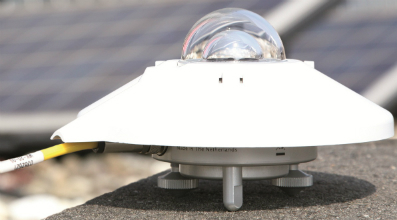Since the commercial introduction of the original crystalline silicone solar cells a whole new range of technologies has become available and even more are on the way. One of these technologies is thin film solar cells. In this category amorphous silicon has the biggest market share and is the main research field of the PVMD group.
All technologies have their own advantages and drawbacks. This could be in efficiency, cost, or weight, for example. The differences could also depend on the illumination condition such as direct or diffuse light, spectrum and temperature. For example, an amorphous silicon solar cell performs relatively better in diffuse light than crystalline solar cells.
 For characterisation the PVMD group uses standard test conditions of 1000 W/m² irradiation with the spectrum of 1.5 Air Mass and a panel temperature of +25 °C. This makes it possible to compare the different technologies for those conditions. But in real life those conditions are seldom met. Therefore it cannot be concluded which technology is best suited for a certain application.
For characterisation the PVMD group uses standard test conditions of 1000 W/m² irradiation with the spectrum of 1.5 Air Mass and a panel temperature of +25 °C. This makes it possible to compare the different technologies for those conditions. But in real life those conditions are seldom met. Therefore it cannot be concluded which technology is best suited for a certain application.
At the moment the PVMD test site consists of six older multi-crystalline solar arrays, from which we are monitoring the direct current and voltage. The temperature of the solar modules is also monitored. In the near future we will install different PV technologies such as micro-morph thin film modules. This will not be the last expansion. We want to create a good and comprehensive test site with as many different technologies as possible.
We are using the CMP 11 pyranometer from Kipp & Zonen to measure the global irradiance. This is our reference for the solar input since it includes all the irradiance from the total hemisphere. The specifications of the CMP 11 make it a reliable sensor to base our conclusions on. With the planned expansion of the test site more pyranometers will be added too; for example to measure the in-plane irradiance.
With all the data collected we hope to get a better insight into the differences between technologies. Hopefully, it will also give us an indication how to improve the performance of the solar modules.
The data collected from monitoring the PV modules will also be used for educational purposes. The use of sustainable energy sources also has great effects on the electricity grid. The sun is not always shinning! To give better insights into these production fluctuations we can use this data. The students, and other people that are interested, can use this data to design better PV systems. Therefore, the data is made available for everyone to use.
For more information about the PVMD group at TUDelft please visit:
http://pvmd.ewi.tudelft.nl And for the PV monitoring site and system visit:
http://pvmonitoring.ewi.tudelft.nl/pvmon.html